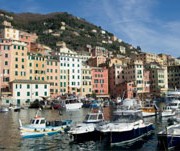Top 5 Spring festivals in Italy
Easter Week, Rome & Florence: 29th March-1st April
If you can be in Italy during Easter Week you will be treated to splendid traditions, poignant rituals and abundant food as Lent reaches its end. While Easter Mass is held across the country in every church, it’s the one led by the Pope at St Peter’s Basilica in Rome that tops the agenda. He also blesses the Via Crucis on Good Friday, where a huge cross is lit with burning torches near the Colosseum. Alternatively, head for Florence where the Scoppio del Carro, or explosion of the cart, provides a spectacular display of fireworks and parades in medieval costume on Easter morning. Wherever you are, Easter Monday, or La Pasquetta, is a day of festivity, fun and social gatherings – to say nothing of fine food and wine, which goes without saying.
Festa di San Marco, Venice: 11th-12th May
All you romantics out there, head for Venice on 25th April. As well as being Liberation Day in Italy, celebrating the anniversary of Italy’s liberation by the Allies in WWII, it is also the feast day of Venice’s patron saint, San Marco. And it is during this Festa de San Marco that Venetian men traditionally present the woman they love with a red rosebud, or bocolo. Enjoy the parades in St Mark’s Square and woo your beloved in one of Italy’s most beautiful cities – guys, this one will win you brownie points with your loved one.
Sagra del Pesce, Camogli: 12th May
It would be impossible to talk of festivals in Italy without bringing up food at some point. The Sagra del Pesce (Fish Feast) Festival in Camogli, just south of Genoa, is a must for anyone who likes fish as, every year on the second Sunday of May, this small and pretty fishing village perched on the Italian Riviera hosts a massive, jovial and free feast of freshly caught fish. And it really does have to be seen to be believed. For the entire day, fishermen swap their nets for aprons and devote the day to frying their produce in a giant saucepan that’s 5 metres wide (that’s over 16 feet) with a 7 metre handle – possibly even more impressive than the fish that comes out of it. Whatever the case, it’s fish for everyone – it’s delicious, and it’s free!
Infiorata di Noto, Sicily: 12th May-20th June
Spring is a time for flowers, and there’s nowhere better to get your fill of colour and scent than in the picturesque Baroque town of Noto in southeast Sicily. On the third weekend in May the pavements of Noto are covered with intricate ‘carpets’ of flower petals that form stunning mosaic patterns and pictures. Local artists go to town with their designs which are all made out the most natural materials possible – in addition to flower petals, they use earth, wood cuttings, seeds and more. The artists begin their creations on Friday, for all to enjoy over the weekend, and then on Monday children are let loose with delight to run through the flowers and destroy the designs. But, at least for one weekend, locals and visitors to Noto look down rather than up, as usually it is the beautiful balconies overhead that catch the eye, not the pavement underfoot.
Festival dei Due Mondi, Spoleto: 28th June-14th July
The pretty hill town of Spoleto in southern Umbria plays host to the Festival dei Due Mondi, one of Italy’s most famous performing arts festivals. So-called as its founder, composer Gian Carlo Menotti, hoped to bring together the old and new worlds of Europe and America, it is a packed programme of music, opera, theatre, art and sculpture, and each year draws in first-class artists from around the world. As can be expected, Spoleto gets very busy during the festival, but Orvieto is about 90 minutes away and makes a perfect place to escape the crowds whilst still staying within easy distance of the festivities.

